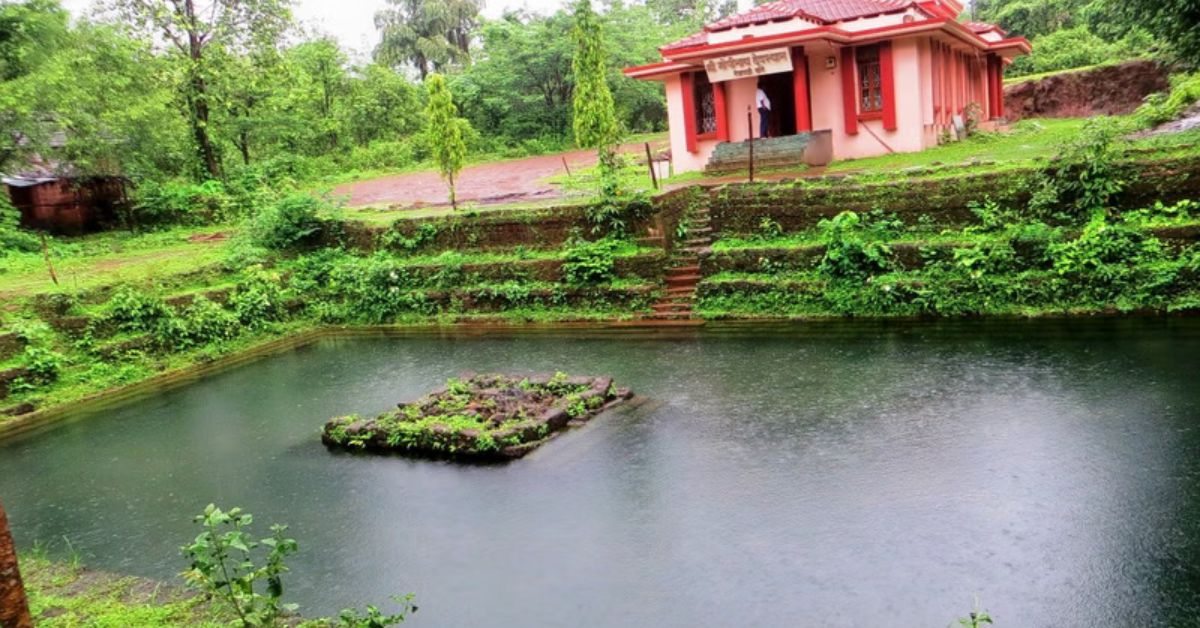Feature image courtesy: Goa Tourism
If lakes could gossip, Budbudyachi Talli would be the one telling tall tales in the village square. On the surface, it’s just another quiet pond in Goa, a place where buffaloes wade lazily and dragonflies hover like tiny drones. But walk closer, clap your hands, and the whole thing comes alive with bubbles, like it’s been keeping a centuries-old secret.
‘Budbudyachi Talli’ means ‘Lake of Bubbles’ in Konkani.
Locals have been baffled and entertained by this 400-year-old water body for generations. Some whisper it’s the work of ancient spirits guarding the village. Others swear it’s nature showing off. And then there are the scientists, who arrive with instruments, leave with theories, and still don’t manage to steal away the pond’s mischief.
A pond with a personality
Beside the Gopinath Temple in Netravali, Sanguem, lies a rectangular, laterite-lined water tank framed with granite steps and a central stone pedestal. The water is crystal clear, tinged with a soft green-blue hue.

From its bed, tiny bubbles rise continuously, forming concentric ripples that break the stillness. The phenomenon becomes even more animated when someone claps or makes a loud sound. This playful interaction has delighted visitors and local children alike.
Steeped in history
Budbudyachi Talli isn’t just a curiosity of nature, it’s intertwined with Goa’s cultural and spiritual heritage.
The tank sits alongside the Gopinath Temple, dedicated to Lord Krishna, believed to date back several centuries. Architectural elements link it to the Shilahara and Kadamba dynasties, with some historians suggesting renovation during the reign of King Jayakeshi I. Behind the temple, rock-cut Shivlings hint at an even older tradition of Shiva worship.
The temple’s style recalls the famed Tambdi Surla temple. And the original Krishna idol from here now rests in the Goa State Museum, preserving its history for future generations.
The science behind the magic, or is it?
Theories abound, but none are conclusive.
- Gas release theory: Natural gases like carbon dioxide or sulphur dioxide may be escaping from underground.
- Sound vibration theory: A clap’s vibrations could disturb trapped gas pockets, causing them to rise.
- Methane (which is unlikely): The presence of fish suggests methane levels are minimal.
- Divine explanation: Many locals believe the bubbling is a blessing from the gods — a sign that the deity is present in the waters and listening. They say that when devotees clap, chant, or call out, the bubbles respond, as if the lake itself is answering. Some even believe the bubbles are the breaths of the deity resting beneath the surface.
From local secret to tourist favourite
For generations, this was a hidden wonder, known mostly to locals. Today, Budbudyachi Talli is drawing travellers from across India.
The Goa Tourism Development Corporation has worked on improving access with better roads, lighting, seating, and parking, all while maintaining the area’s calm.
The site remains free from the rush of mass tourism, making it a perfect spot for those seeking a more intimate, nature-focused experience.
Planning your visit
- Distance: Around 80 km from Panaji via Margao and Rivona
- Nearest railway stations: Margao (50 km) and Canacona (40 km)
- Timings: Generally open from early morning until early evening (approx 8 am to 6.30 pm)
- Best time to visit: October to March for pleasant weather, or the monsoon months for lush greenery
Why it’s worth the trip
This isn’t just about grandeur. Budbudyachi Talli offers a rare blend of history, mystery, and stillness with a dash of playful wonder. In a state known for its beaches, it stands out as a quiet retreat that rewards curiosity.
Whether the bubbles rise in answer to sound waves, underground gases, or something beyond science, Budbudyachi Talli invites you to pause and engage.
One clap, one ripple, and suddenly the water is alive — a reminder that nature often hides its most delightful surprises in the smallest gestures.
 (@theculturegully)
(@theculturegully)
No comments:
Post a Comment